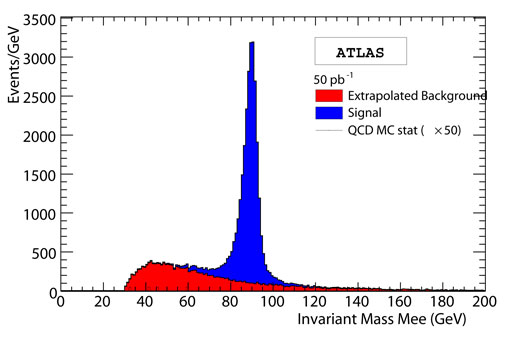
ATLAS e-News
23 February 2011
Learning new tricks from old friends
18 November 2008

Di-electron invariant mass in the Z→ee channel, for signal and background for an integrated luminosity of 50 pb-1. The signal and background fractions are estimated simultaneously, via a fit to both contributions. The signal is described by the convolution of a Breit-Wigner and a Gaussian resolution function, and the background, completely dominated by jet events, by an exponential function.
The study of the W and Z bosons is a fundamental area for the ATLAS early running. The W and Z production comes from clean processes with large cross-sections and, at a 14 TeV centre-of-mass energy, we expect to observe about 250,000 W and 25,000 Z decaying into leptons for an integrated luminosity of 50 pb-1. It’s hard to make reliable predictions on how much data we will get at this stage but we hope to get at least this much integrated luminosity, if not more, next year at a 10 TeV centre-of-mass energy. The expected W and Z cross-sections are about 30% lower at 10 TeV than 14 TeV.
As these processes are very well known theoretically, we will use them to understand the detector and its performance: energy scale and inter-calibration of the electromagnetic calorimeter using Z decay into e+e- pairs, checking the alignment of the muon spectrometer system using Z→μμ, trigger performance and extraction of the lepton identification efficiencies.
The first measurements will be the determination of the W, Z, W + jets and Z + jets cross-sections. With increased statistics, access to fundamental electroweak parameters, like the W mass, will become possible. But these measurements are long term goals, for when the LHC environment is under control and our detectors well understood.
We will measure the W and Z cross-sections through their decay into electrons and muons. They are basically computed by counting the amount of signal and background events passing a given set of selection cuts.
Events are first selected at the trigger level requiring at least one or two lepton candidates depending on the considered channel. The next step is to apply further lepton identification and selection criteria, based on angular and kinematic cuts. For the W→eν and W→μν channels, an additional constraint comes from the reconstructed missing transverse energy, due to the undetected neutrino.
With an integrated luminosity of 50 pb-1, we should achieve a better than 5% precision on the event selection in the W channels, while for the Z, the expected precision may be as good as 3%. These feed directly into the precision of the early cross-section measurement, together with the luminosity uncertainty. While QCD events constitute the largest background to the W→eν and Z→ee channels, for the Z→μμ and W→μν channels the dominant backgrounds come respectively from top quark events and W→τν or Z→μμ events. Though the QCD background is smaller in these last cases, it is unfortunately not well known and our limited knowledge of the jet production cross-section and fragmentation properties at the LHC induce a significant uncertainty on the magnitude of the QCD background.
Another important part of the ATLAS Standard Model physics program is the study of events with W or Z produced with extra jets. Such events are interesting in their own right, as tests of perturbative QCD for example. They also represent an important background to many other Standard Model and beyond Standard Model physics channels (Higgs, supersymmetry…) and we must understand these processes very well before anything can be said about new physics.
Initially, the important amount of W or Z + jets events will be used in early data to test further the detector performance and the jet reconstruction algorithms and techniques. Later on, with more accumulated statistics, Z + jets events will be used to improve the jet energy calibration.
During the CSC efforts, activity in analysis of W/Z events has strongly grown. All the results presented here are the outcomes of these efforts. Though we are not prospecting for ‘new physics’, working on these so-called standard channels is still very exciting and gratifying as we can look out for these events as soon as we get the first 10 TeV collision data.

Damien Prieu rRutherford Appleton Laboratory
|